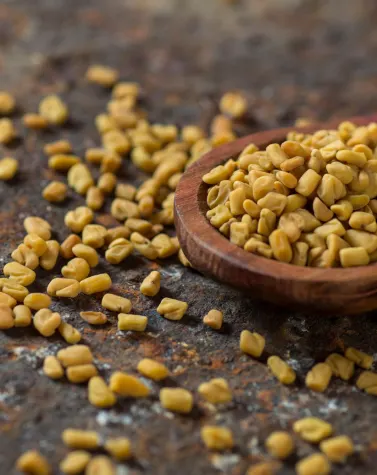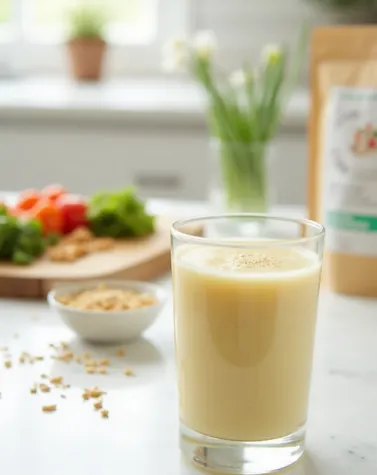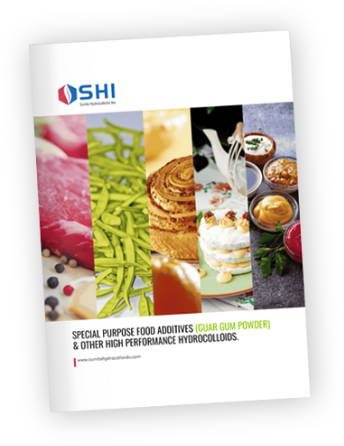
Carrageenan vs Guar Gum: Which Thickener Is Better for Your Health?
From dairy free milks and ice creams to gluten free baked goods, food thickeners – a type of food additive – are showing up in more products than ever. Whether it is to improve texture, extend shelf life or stabilize ingredients, these additives are now a staple in both commercial and home kitchens.
But as ingredient lists grow longer, shoppers are getting smarter. There is an increasing demand for clean label products that are good for the gut. Both carrageenan and guar gum are plant based thickeners used across the food industry but they come from very different sources and have very different reputations.
One is extracted from red seaweed (called Irish moss), the other from guar beans. One is praised for its fiber content, the other questioned for its impact on digestion. This blog breaks down how they compare so you can choose what works best for your health or your product.
What Are Carrageenan and Guar Gum?
I. Carrageenan Gum
Carrageenan is a natural food thickener extracted from red seaweed, often referred to as Irish moss. It has been used for centuries in food preparation and is now a common ingredient in many processed and plant based products. Carrageenan is sometimes considered a source of dietary fiber due to its indigestible polysaccharide content.
It is commonly used in dairy alternatives like almond milk and soy milks, deli meats and processed poultry, puddings, custards and vegan desserts. Carrageenan gels, thickens and stabilizes and keeps ingredients from separating, rendering products a creamy, uniform texture. It is especially popular in vegan recipes as a substitute for gelatin.
While Carrageenan is widely used, it has sparked debate around digestive health. Some studies suggest carrageenan may induce inflammation in the gut, though regulatory agencies consider it safe in regulated amounts. Some consumers are cautious about its impact on the gut, especially those with sensitive digestion. Still, food grade carrageenan remains approved for use in regulated amounts.
II. Guar Gum
Guar gum is a plant based thickener made from the seeds of the guar bean, a legume grown in India and Pakistan. Once ground into a fine powder it’s a super ingredient in food and industrial applications. Guar gum is used in baked goods like gluten free breads and cookies, sauces, salad dressings and condiments, frozen desserts like ice creams and is super popular in health food products.
It’s high in fiber and strong thickening power (up to 8 times more than corn starch). Guar gum is also a binder and moisture retainer, so it’s a favorite in gluten free and low fat recipes. Its soluble fiber may support digestion by promoting good bacteria growth in the gut and the digestive tract. Some people may experience bloating if they consume too much of it.
How They Work: Texture, Stability and Use in Foods
When it comes to food texture and performance, both carrageenan and guar gum bring unique strengths to the table. The rheological properties of carrageenan and guar gum play a crucial role in determining the texture, viscosity and gel structure of various foods. But how do they actually behave in real recipes?
Thickening Strength, Gelling Agent Properties and Solubility
- Guar gum is a thickener powerhouse. It hydrates quickly in cold water and can thicken at very low concentrations. Compared to corn starch, guar gum is way more efficient as a thickener. You need less to achieve the same viscosity.
- Carrageenan is more specialized. It forms gels in the presence of certain salts and is often used when a firmer or more elastic texture is needed.
Guar gum is better for quick thickening while carrageenan is ideal for structured gels and creamy finishes.
Temperature and pH Stability
- Carrageenan holds up well under heat and works across a range of pH levels, making it a go to for hot dairy applications.
- Guar gum performs best in cold or room temperature settings and may lose some viscosity in acidic or high heat environments.
Common Food Applications in Processed Foods
- Carrageenan is used in dairy products, meat products and nut milk as well as plant based milks and puddings to prevent separation and improve mouthfeel.
- Guar gum is found in gluten free baked goods, salad dressings and frozen desserts for its moisture retention and thickening power.
Other gums such as tara gum, carob gum (locust bean gum) and acacia gum (gum Arabic) are also used as thickeners and stabilizers in similar food applications. Both are widely used thickening agents but the right choice depends on your product’s texture goals, processing conditions and dietary needs.
Comparison of Carrageenan and Guar Gum
| Feature | Carrageenan | Guar Gum |
| Source | Red seaweed | Guar bean (legume) |
| Primary Use | Gelling agent | Thickener/stabilizer |
| Health Concerns | Linked to gut inflammation in some studies; may cause issues for those with food intolerances | Generally safe, mild GI side effects possible; may affect those with food intolerances |
| Labeling | Food additive; sometimes avoided on “clean labels” | Food additive; widely accepted in natural and health food products |
| Applications | Nut milks, deli meats, jellies | Baked goods, dairy free products |
| Nutritional Value | No significant nutritional value | Contains dietary fiber |
While carrageenan is effective for firm gels and protein stabilization, guar gum is preferred for gluten free and fiber enriched foods due to its dietary fiber content.
Other gums such as acacia gum (derived from the acacia tree), carob gum (locust bean gum) and tara gum are also used as additives in the food industry for their thickening, stabilizing and emulsifying properties. These alternatives are often found in health food products and may be considered by those seeking options with different nutritional value or for individuals with specific food intolerances.
Carrageenan: What You Should Know About Gut Health
While carrageenan approved for use in food products, it has raised questions about its effect on digestion. Some studies suggest that carrageenan may trigger an inflammatory response in the gut, especially in people with pre existing conditions like IBS (Irritable Bowel Syndrome) or IBD2. It has been linked to changes in gut bacteria and may disrupt the intestinal lining in sensitive individuals. This can lead to symptoms like bloating, cramping or loose stools.
That said, food grade carrageenan is still considered safe in small amounts by regulatory bodies. The key is moderation and awareness. If you have a sensitive digestive system, it may be worth checking labels and choosing carrageenan free options when possible.
Guar Gum: Fiber Rich but Not for Everyone
Guar gum is a natural thickener made from guar beans and is part of a broader group of food gums. It’s used in gluten free baking, sauces and frozen desserts. What sets it apart is its high soluble fiber content which can support digestion and help regulate blood sugar by working on the digestive tract.
However, some people, especially those with sensitive guts and food intolerances, may experience bloating or gas when consuming guar gum. If you are introducing guar gum into your diet or product line, it is smart to start with small amounts and monitor how it is tolerated especially since many processed foods are formulated with gum additives.
Other gums such as tara gum, carob gum (locust bean gum) and acacia gum (gum Arabic) are also used as alternatives in food processing.
Cost, Availability and Label Transparency
When it comes to cost and sourcing, guar gum often has the edge. It’s widely produced in India and is cheaper than carrageenan especially in large scale food manufacturing. Its high thickening power also means you need less of it per batch which adds to its cost efficiency.
If you’re looking for affordable alternatives, corn starch is a common, all purpose thickener used in many recipes and food products. Other gums such as acacia gum (sourced from the acacia tree), carob gum (also known as locust bean gum) and tara gum are also used as food additives for thickening and stabilizing foods like ice cream, candies, syrups and baked goods. Each of these has different cost and sourcing profiles and their use may depend on product positioning.
Carrageenan while still common tends to be slightly more expensive due to its seaweed origin and processing methods. It is often used in premium dairy alternatives and processed meats. For guar gum, opt for organic or non GMO sources when possible.
Which One Should You Choose?
Choosing between carrageenan and guar gum depends on your health goals, dietary needs and how you plan to use them. Guar gum is best for sensitive stomachs. If gut health is a concern, guar gum may be the safer bet. It is perfect for baking or cold foods and works well in cold applications and gluten free baking.
Carrageenan is more heat stable and better suited for hot dairy-based recipes or gelled desserts. Both gums are vegan friendly but carrageenan is more common in dairy free milks and cheeses for its creamy texture. Guar gum is often used in sauces, frozen desserts and clean label gluten free products.
Related Reads on Natural Thickeners
If you’re exploring plant-based thickeners and want to dive deeper into how they compare and perform in different food applications, check out these related articles:
- Guar Gum vs Gum Arabic : Discover how guar gum stacks up against gum Arabic in terms of texture, solubility, and clean label appeal.
- Locust Bean Gum vs Guar Gum : Learn the differences between these two popular seed-based thickeners and how they influence food texture and stability.
- Guar Gum in the Food Industry : A comprehensive look at guar gum’s role in modern food manufacturing—from gluten-free baking to frozen desserts.





